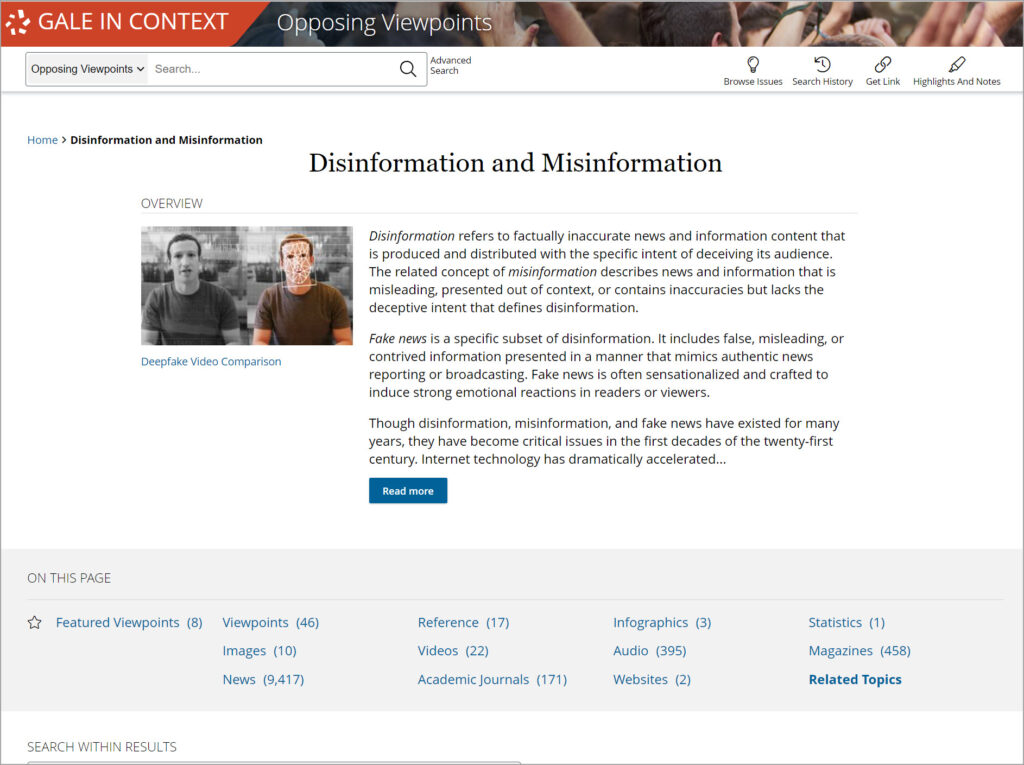| By Gale Staff |
High school educators know that strong digital literacy is a cornerstone of successful education in the 21st century. As technology becomes ever more pervasive in the classroom, it’s important for students to learn how to maintain a responsible online presence and identify facts from biased or misleading information. Understanding how to navigate the digital world is instrumental to a child’s future success, but many schools don’t have the infrastructure or tools to fully embed these skills into their curricula.
Gale is excited to announce our recently published Gale In Context: Opposing Viewpoints portal for Disinformation and Misinformation, a new and compelling resource for high school teachers to integrate into their lesson plans. This collection features a leading reference article, providing users with a helpful summary of the issues at hand. Moreover, we’ve included statistics, interactive infographics, videos, and more.

Define the Problem
To help students identify inaccurate information online, it’s important to start by building a vocabulary of what to look for. While not everything they read is necessarily untrue, facts are sometimes presented or skewed to lead others toward a certain opinion. Defining the problem can help students better identify falsehoods and biases when they encounter them.
Disinformation is purposely untrue information designed to deceive readers. This strategy is often used during election season when political stakeholders seek ways to discredit or slander their opponents. Misinformation isn’t quite so malicious. In the case of misinformation, an individual may believe something to be true and post that information in good faith of its accuracy. Misinformation describes news or other sources of information that are misleading or present only part of the truth.
Confirmation bias poses another threat to accurate research. Confirmation bias is less about the information itself and more about how a reader’s personal beliefs might color how that information is interpreted. Students must practice putting their unique opinions aside before engaging in research. Otherwise, they’ll be vulnerable to misinformation. Your classroom presents a safe place for students to step outside their comfort zones and be curious. Let them know that it’s okay to disagree, yet it’s equally okay to be wrong about something.
Create Responsible Digital Citizens
The fake news phenomenon poses a real concern. One study from the 2016 election cycle demonstrates that fake news stories spread faster than real news stories. When citizens can’t tell truth from fiction, people begin to lose trust in journalists, doctors, and scientists. This is why it’s important for young learners to understand how to be responsible digital citizens.

Students must research the source, fact check, avoid clickbait headlines, vet supplemental links to studies or surveys, reflect on their personal beliefs to avoid confirmation bias, and consult with a teacher or librarian when they are unsure about an article’s validity. Train your students to question and scrutinize the information they engage with online to keep them from falling victim to fake news. A little skepticism can go a long way.
Combat Fake News
Educators aren’t alone in this fight. Major social media platforms have increased efforts to stop misleading information from trending on their sites, and users can more easily flag suspicious posts. Some digital companies are even investing in fact-checking agencies, local journalism, and institutions analyzing the technology behind certain disinformation strategies. Fake videos and audio are also becoming ever more challenging to identify. Luckily, with Gale products, you won’t need to worry about fake news or misleading articles in your search results. Our team of content experts vet the resources available through our platforms to ensure that the information is reliable.
Practice Identifying False Information
Encourage your students to browse Gale’s Disinformation and Misinformation portal and ask them to share something that may have surprised them. As a group, discuss strategies for identifying falsehoods or misinformation. Using traditional search engines, have your students search for a topic in which they are interested and practice analyzing the top results for accuracy. Certain news items, including the pandemic, are rich with challenging viewpoints and misleading information. Students can present their findings to the class, discuss their personal biases, and allow others to question the integrity of what they’ve discovered as well. Doing so will help them practice implementing vital, real-world skills.
Help your students master the fundamentals of good digital citizenship. Ready to get started? Learn more about Gale In Context: Opposing Viewpoints today!

